We try to grow a wide variety of vegetables and fruits in our gardens. To obtain significant harvests, you need not just regular fertilizing, but for each plant you need to choose your own individual menu.
Even organic fertilizers (especially manure) must be applied to the beds taking into account what kind of crop is here will be sown, planted. Cabbage and cucumbers will not mind if you fertilize their beds with even fresh manure in the fall.But early ripening varieties of these crops will not have time to use the nutrients released during the decomposition of organic matter.
Fresh organic matter added to carrots causes root crops to branch; in onion beds, the bulbs do not ripen and are poorly stored. Tomatoes overfertilized with fresh organic matter produce a lot of leaves and few fruits. But this applies to fresh organic matter.
It is not forbidden to apply well-decomposed humus and compost to these same crops. How much to apply depends on the soil. If the humus content is low, a bucket of humus per square meter. m will not be overkill.
Plants also differ in their need for individual nutrients. Some require more nitrogen for normal development, others require potassium or phosphorus. Plants have different needs for microelements. The rates and timing of fertilizer application depend not only on the crop, but also on the soil.
Fertilize cabbage
U cabbage appetites are better than other vegetables. This is understandable. To grow a huge mass of powerful leaves, for example, cauliflower, requires a lot of “building materials”. Cabbage works well if you fill the soil under it with humus and add mineral fertilizers. 3-4 kg of humus, 1.5-2 tbsp. spoons of superphosphate and potassium sulfate are added when digging the soil.
For late and mid-season cabbage varieties, you can apply manure; for early varieties, only good humus or compost. Organic infusions are effective as fertilizing (mullein - 1:10, bird droppings - 1:20). For every 10 liters of infusion add 1-1.5 tbsp. spoons of superphosphate.
During the period of active growth and setting a head of cabbage, cabbage needs nitrogen and potassium. At this time, it is better to feed the cabbage with complex fertilizers with microelements.Late-ripening varieties of cabbage at the end of the growing season are fed with wood ash or increased rates of potassium sulfate and superphosphate.
Nitrogen introduced at the end of the season causes the accumulation of nitrates in heads of cabbage, delays development, reduces the resistance of cabbage to diseases, and promotes cracking of heads of cabbage.
Cauliflower definitely needs fertilizers containing molybdenum.
How to properly fertilize cucumbers
Cucumbers require two times less mineral fertilizers than cabbage. But the rate of organic matter application can be increased to 6-9 kg per square meter. m, if the soil is poor in humus. At the beginning of the growing season, cucumbers are sensitive to high concentrations of salts, especially on light soils (sandy, sandy loam). That's why feed the cucumbers start already in the flowering phase, do this often (every 7-10 days), but in small quantities.
If you use simple fertilizers (urea, superphosphate, potassium sulfate), then a teaspoon of each per bucket of water is enough. Complex payments are made based on Art. spoon, mullein infusion - 0.5 liters per bucket of water.
Large amounts of fertilizer applied in the initial period can lead to the death of plants.
Feeding tomatoes
Tomatoes extract many nutrients from the soil. Most of all they need potassium, a little less - nitrogen. Tomatoes consume several times less phosphorus than potassium, but it plays an exceptional role in fruit formation. It is very important that plants receive phosphorus already during the seedling period (a teaspoon of superphosphate per kg of soil mixture).
Seven times less nitrogen and potassium fertilizers are added to this volume of soil. In this situation, the seedlings bloom and begin to bear fruit earlier.
Tomatoes especially need potassium during the period of fruit formation and ripening.It is better to apply mineral fertilizers in dissolved form during the growing season for tomatoes.
Tomatoes are responsive to organic matter: 4-6 kg of humus per square meter. under digging. At the same time, the bulk of the mineral fertilizers necessary for the development of tomatoes is added: Art. spoon of superphosphate and 2 tbsp. spoons of potassium sulfate per sq. m. Humus and compost can be added to each hole when planting. On light soils, manure is also used, but only for autumn digging (4-5 kg per sq. m). Manure, like nitrogen fertilizers, promotes strong development of vegetative mass to the detriment of fruiting.
- The first vegetative feeding is carried out during the period of budding and the beginning of flowering: add 0.5 liters of organic infusion (chicken manure, mullein, green grass) and superphosphate extract prepared from Art. spoons of fertilizer.
- The second feeding is during the flowering period of the second cluster: for 10 liters of water, 0.5 liters of organic infusion and a tablespoon of complex mineral fertilizer.
- The third feeding is during the flowering period of the third cluster: a tablespoon of complex fertilizer per 10 liters of water.
Feed eggplants and peppers correctly
Eggplants and peppers are demanding on soil fertility. IN eggplant seedling period responsive to nitrogen and phosphorus fertilizing. Per kilogram of soil mixture in which seedlings are grown, add a teaspoon of superphosphate and five times less urea and potassium sulfate.
In areas where it is planned to grow these crops, 2 tbsp are added for autumn digging. spoons of superphosphate and potassium sulfate.
- The first vegetative feeding is carried out 7-10 days after planting the seedlings: a teaspoon of potassium sulfate and urea and a tablespoon of superphosphate (extract) per 10 liters of water.
- The second feeding is during the period of mass flowering: 0.5 l.infusion of mullein, herbs or a teaspoon of urea per 10 liters of water.
- The third feeding is during the fruiting period: a teaspoon of potassium sulfate and 0.5 l. fermented grass per 10 liters.
Selecting a menu for peas
Legumes do not require many nutrients; they are able to “extract” nitrogen from the air themselves.
Still, they love fertile soil and prefer to grow after crops that have been treated with organic fertilizers (cabbage, cucumbers, tomatoes). On light soils, it is recommended to add wood ash to legumes - up to 0.5 cups per square meter. m.
During the autumn digging, add a tablespoon of superphosphate and potassium sulfate. In the spring, to give an impetus to growth, add a little nitrogen fertilizer - a teaspoon of urea per square meter. m. But you can do without them. When there is an excess of mineral nitrogen in the soil, nodule nitrogen-fixing bacteria develop poorly on the roots of legumes.
What fertilizers do potatoes prefer?
We most often propagate potatoes by tubers, which contain enough substances to ensure the growth of young plants. Still, potatoes need a lot of nutrients to produce a harvest. The “appetite” of potatoes can be compared to the “appetite” of cabbage.
Potato consumption of nitrogen, phosphorus, and potassium increases during the period of active growth and decreases after flowering and tuber formation.
For autumn digging, 3-4 kg of humus, up to three tablespoons of superphosphate, and half a glass of wood ash per square meter are added to the soil of the future potato plot. m.
In the spring, to stimulate the growth of tops, potatoes are fed with an infusion of fermented grass. During the budding period, wood ash is scattered into the potato rows, loosened and watered.Or they apply complex fertilizers for potatoes (for example, potato fertilizer).
Feeding root vegetables
Carrot sown after crops to which organic matter was added.
- In the phase of 3-4 leaves, to give impetus to the growth of tops, carrots are fed with a weak organic infusion: a glass of mullein or chicken manure per 10 liters of water.
- After 2-3 weeks, the feeding is repeated: a glass of organic infusion and a tbsp. spoon of potassium sulfate per 10 liters of water. You can limit yourself to only mineral fertilizing: 2 tbsp. spoons of complex fertilizer per 10 liters of water.
- With the third feeding during the period of root crop formation, carrots should receive potassium: 1-1.5 tbsp. spoons of potassium sulfate per 10 liters of water.
Beetroot They feed almost the same.
- The first feeding at the stage of 3-4 true leaves: 0.5 liters of organic infusion (mullein or green grass), a tablespoon of complex fertilizer, which contains boron.
- After three weeks, add wood ash between the rows, cover it with a hoe and water it.
- Third feeding during the growth phase of root crops: Art. spoon of potassium sulfate per 10 liters of water.
Fertilize onions
In garden crop rotation, onions are placed after crops to which organic matter was added (potatoes, tomatoes, cucumbers). Legumes are considered good predecessors. Up to 5 kg of humus or compost, a tablespoon of superphosphate and 1.5 tbsp are added to poor soil for autumn digging. spoons of potassium sulfate per sq. m. In the spring, urea is added - about a tablespoon per square meter. m.
Onion, grown by sowing seeds (nigella), is fed for the first time in the phase of appearance of the fourth leaf:
- Infusion of mullein (1:10) or chicken manure (1:20), consumption - a bucket of 3-4 square meters. m. Make grooves 6-8 cm deep between the rows, water them with fertilizer infusion and cover them with soil.
- After two weeks, a second feeding is carried out: a teaspoon of urea and potassium sulfate, 2 teaspoons of superphosphate per square meter. m.
Onions grown from sets are fed more generously:
- First feeding (at the stage of 3-4 leaves): 0.5 tbsp. tablespoons of urea, a tablespoon of superphosphate and potassium sulfate per square meter. m.
- A month later, another feeding - with an extract of superphosphate (2 tablespoons per bucket of water).
How to feed garlic
The soil for garlic is prepared in the same way as for onions.
- In the spring at the beginning of leaf growth garlic is fed nitrogen: st. spoon of urea per sq. m.
- After two weeks, the second feeding: Art. spoon of complex fertilizer per 10 liters of water.
- The third feeding at the beginning of summer is with superphosphate extract (2 tablespoons per 10 liters of water).
When fertilizing any crop, you must remember and follow the main rule:
It is better to underfeed a plant than to overfeed it!
Continuation of the topic:
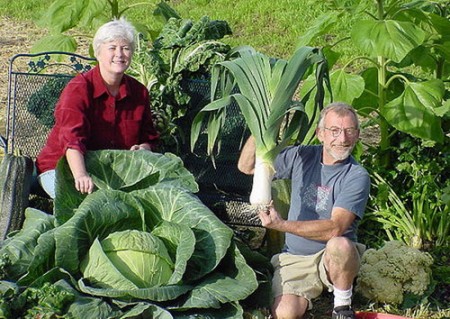
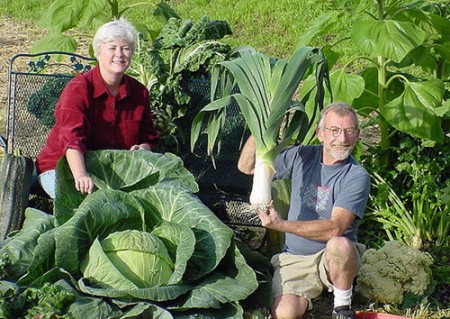
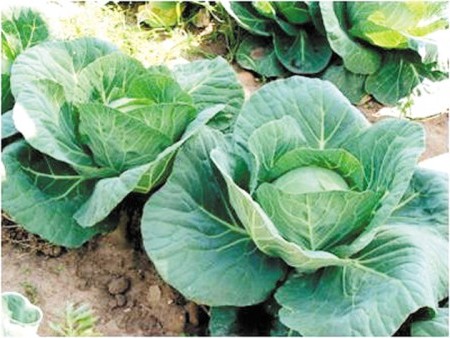
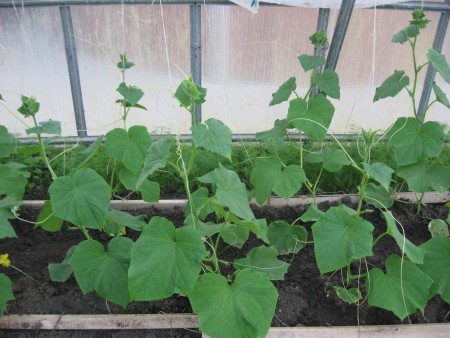
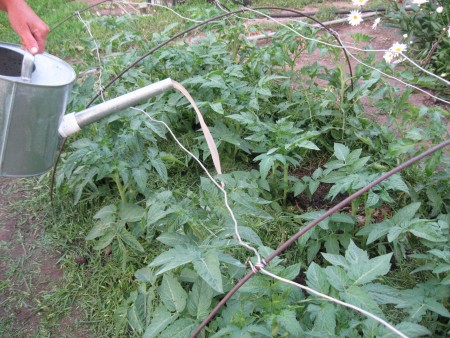


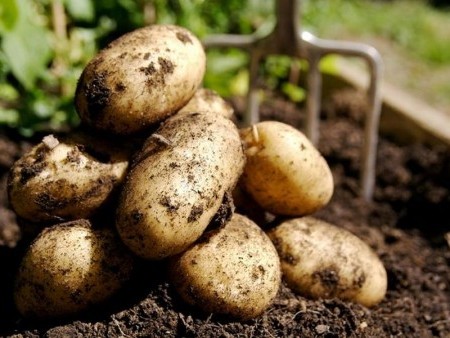

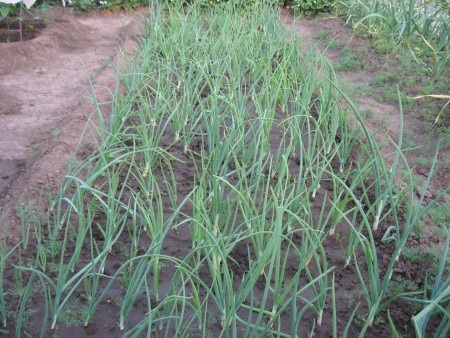
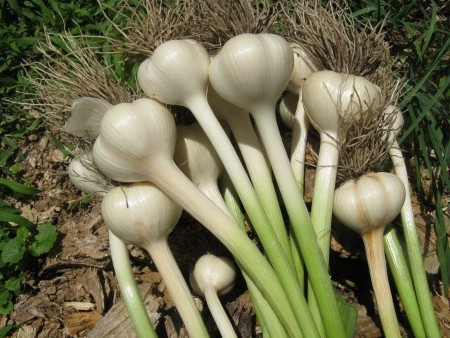

 CUCUMBERS NEVER GET SICK, I'VE BEEN USING ONLY THIS FOR 40 YEARS! I SHARE A SECRET WITH YOU, CUCUMBERS ARE LIKE THE PICTURE!
CUCUMBERS NEVER GET SICK, I'VE BEEN USING ONLY THIS FOR 40 YEARS! I SHARE A SECRET WITH YOU, CUCUMBERS ARE LIKE THE PICTURE! You can dig a bucket of potatoes from each bush. Do you think these are fairy tales? Watch the video
You can dig a bucket of potatoes from each bush. Do you think these are fairy tales? Watch the video
 How our fellow gardeners work in Korea.There is a lot to learn and just fun to watch.
How our fellow gardeners work in Korea.There is a lot to learn and just fun to watch. Eye trainer. The author claims that with daily viewing, vision is restored. They don't charge money for views.
Eye trainer. The author claims that with daily viewing, vision is restored. They don't charge money for views. A 3-ingredient cake recipe in 30 minutes is better than Napoleon. Simple and very tasty.
A 3-ingredient cake recipe in 30 minutes is better than Napoleon. Simple and very tasty. Therapeutic exercises for cervical osteochondrosis. A complete set of exercises.
Therapeutic exercises for cervical osteochondrosis. A complete set of exercises. Which indoor plants match your zodiac sign?
Which indoor plants match your zodiac sign? What about them? Excursion to German dachas.
What about them? Excursion to German dachas.